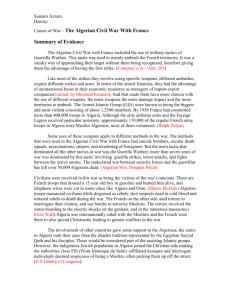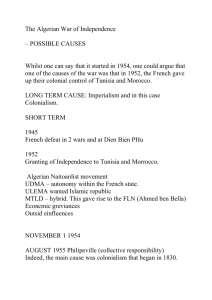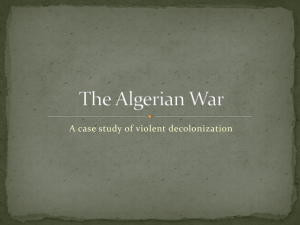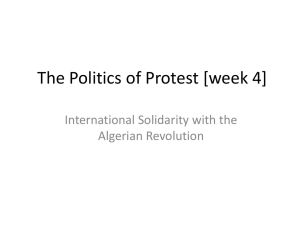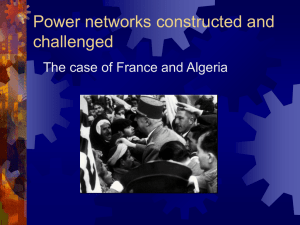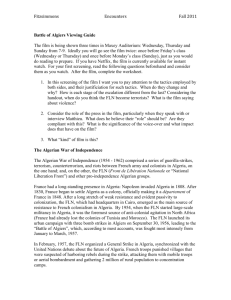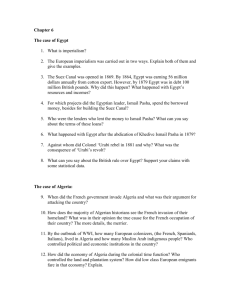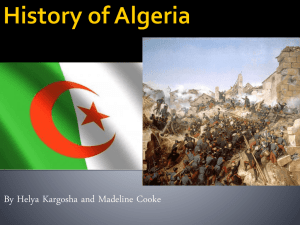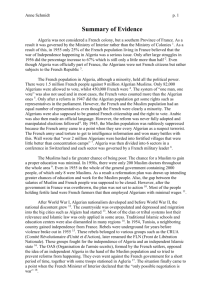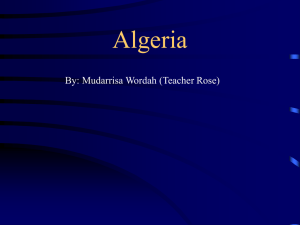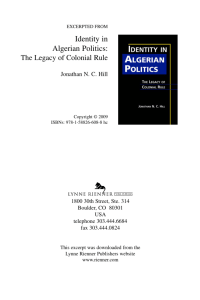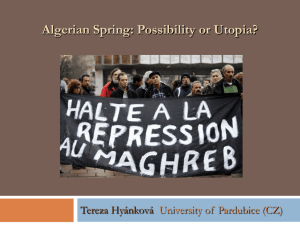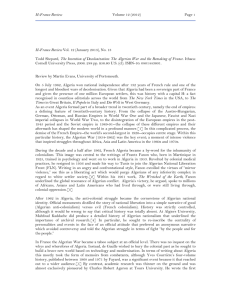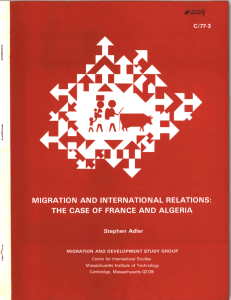Algeria: France's Undeclared War
advertisement
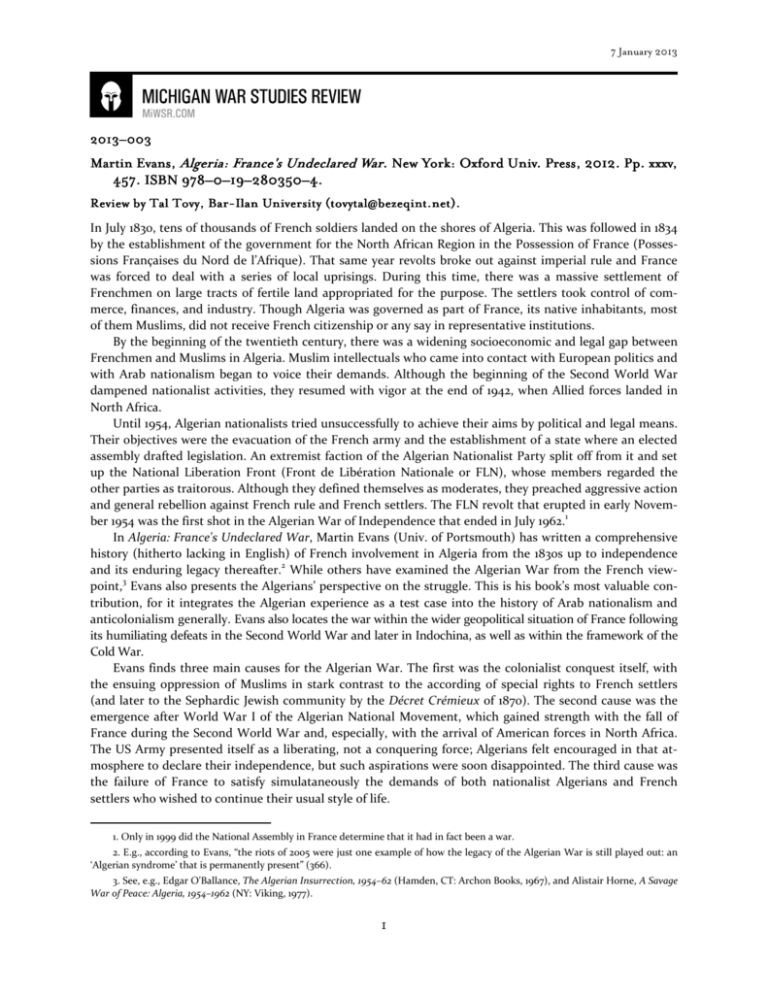
7 January 2013 2013 2013– 003 Martin Evans, Algeria: France's Undeclared War. New York: Oxford Univ. Press, 2012. Pp. xxxv, 457. ISBN 978– 978–0–19– 19–280350– 280350–4. Review by Tal Tovy, BarBar- Ilan University (tovytal@bezeqint.net). (tovytal@bezeqint.net). In July 1830, tens of thousands of French soldiers landed on the shores of Algeria. This was followed in 1834 by the establishment of the government for the North African Region in the Possession of France (Possessions Françaises du Nord de l’Afrique). That same year revolts broke out against imperial rule and France was forced to deal with a series of local uprisings. During this time, there was a massive settlement of Frenchmen on large tracts of fertile land appropriated for the purpose. The settlers took control of commerce, finances, and industry. Though Algeria was governed as part of France, its native inhabitants, most of them Muslims, did not receive French citizenship or any say in representative institutions. By the beginning of the twentieth century, there was a widening socioeconomic and legal gap between Frenchmen and Muslims in Algeria. Muslim intellectuals who came into contact with European politics and with Arab nationalism began to voice their demands. Although the beginning of the Second World War dampened nationalist activities, they resumed with vigor at the end of 1942, when Allied forces landed in North Africa. Until 1954, Algerian nationalists tried unsuccessfully to achieve their aims by political and legal means. Their objectives were the evacuation of the French army and the establishment of a state where an elected assembly drafted legislation. An extremist faction of the Algerian Nationalist Party split off from it and set up the National Liberation Front (Front de Libération Nationale or FLN), whose members regarded the other parties as traitorous. Although they defined themselves as moderates, they preached aggressive action and general rebellion against French rule and French settlers. The FLN revolt that erupted in early Novem1 ber 1954 was the first shot in the Algerian War of Independence that ended in July 1962. In Algeria: France's Undeclared War, Martin Evans (Univ. of Portsmouth) has written a comprehensive history (hitherto lacking in English) of French involvement in Algeria from the 1830s up to independence 2 and its enduring legacy thereafter. While others have examined the Algerian War from the French view3 point, Evans also presents the Algerians’ perspective on the struggle. This is his book’s most valuable contribution, for it integrates the Algerian experience as a test case into the history of Arab nationalism and anticolonialism generally. Evans also locates the war within the wider geopolitical situation of France following its humiliating defeats in the Second World War and later in Indochina, as well as within the framework of the Cold War. Evans finds three main causes for the Algerian War. The first was the colonialist conquest itself, with the ensuing oppression of Muslims in stark contrast to the according of special rights to French settlers (and later to the Sephardic Jewish community by the Décret Crémieux of 1870). The second cause was the emergence after World War I of the Algerian National Movement, which gained strength with the fall of France during the Second World War and, especially, with the arrival of American forces in North Africa. The US Army presented itself as a liberating, not a conquering force; Algerians felt encouraged in that atmosphere to declare their independence, but such aspirations were soon disappointed. The third cause was the failure of France to satisfy simulataneously the demands of both nationalist Algerians and French settlers who wished to continue their usual style of life. 1. Only in 1999 did the National Assembly in France determine that it had in fact been a war. 2. E.g., according to Evans, “the riots of 2005 were just one example of how the legacy of the Algerian War is still played out: an ‘Algerian syndrome’ that is permanently present” (366). 3. See, e.g., Edgar O'Ballance, The Algerian Insurrection, 1954–62 (Hamden, CT: Archon Books, 1967), and Alistair Horne, A Savage War of Peace: Algeria, 1954–1962 (NY: Viking, 1977). 1 Tovy - 2 The book is based on meticulous research in the primary sources and the relevant secondary literature. Although it puts forth no new discovery or revolutionary thesis, it furnishes the historical background for a better understanding of, among other things, events in Algeria from the end of the war to the consolidation of the Islamic movement, the bloody civil war, and the plight of Algerian emigrants to France. Evans’s focus on the Algerian War makes his book relevant for those studying insurgency and counterinsurgency (COIN), both from a purely historical viewpoint and as a practical aid to coping with irregular forces operating today’s world. Almost immediately after the war, American strategists began to examine French COIN tactics in Algeria as they made plans for dealing with the insurgency in Vietnam. For example, the Special Operations Research Office (SORO) at American University published a study of the Algerian 4 War in its series on insurgency and revolution. It identified two stages of the war. In the first, the French were on the defensive; in the second, beginning in late 1957, they went over to the offensive. According to the SORO research, in the earlier phase the French relied on fortified positions built near village settlements. From these forts, patrols went out to lay ambushes or to conduct large-scale operations from time to time. The futility of these activities was evident in increased and intensified FLN attacks and acts of terror in the cities. The proximity of the French forts to villages thus did not ensure control over the local rural populations; indeed, it provided rebels with information about the movements of French forces. Since French raiding and patrol units, being limited in manpower and weaponry, moved along fixed routes, guerrillas could evade them or lay their own ambushes for them. The larger French operations lacked the element of sur5 prise and gave rebels time to escape. These factors together led the FLN to change tactics and conduct attacks more and more daring in range and power. In response, French tactics and strategy changed between 1957 and 1959, when the elite parachute corps and the Foreign Legion arrived. French army personnel in Algeria increased significantly (at their peak, about 400,000 troops). Regions with high concentrations of guerrillas were declared security zones. Their inhabitants were relocated and their villages destroyed to deprive the rebels of food stores and hiding places. The security zones were accessible only to French troops, who had permission to fire freely. The offensive initiative of the parachute units and the Foreign Legion eliminated the rebel underground infrastructure in the main cities, while strong, mobile task forces acted very effectively in the countryside. The power of the French army forced the FLN to act only against isolated and weak units, and only when 6 certain of success. Evans’s thorough analysis of the Algerian War clarifies both the techniques of guerrilla insurgents and the best methods for dealing with them, while taking advantage of the strengths of conventional warfare. It demonstrates that productive COIN strategy depends on maintaining an offensive stance to keep guerrilla units off balance and unable to secure and maintain bases in specific locations for any length of time, thereby limiting their contacts with local populations. Offensive COIN operations should include efforts to blockade borders in order to deny guerrillas needed weapons and reinforcements. While elite, highly mobile forces inflict heavy damage on rebel units, it is even more vital to enlist the support of local people. Such assistance in Algeria allowed the French to deprive guerrillas of bases and sustenance, most crucially in the villages. This transformed the rebels into a hunted minority, vulnerable to the French army’s superior manpower and logistics. Evans notes, too, that good COIN practice includes arming villagers so they can feel they are protecting their families and homes. Proper medical care, educational opportunities, and improved agricultural methods are other effective means to win the cooperation of villagers. 4. Paul A. Jureidini, Case Studies in Insurgency and Revolutionary Warfare, vol. 2: Algeria 1954–1962 (Washington: SORO, 1963); cf. the Rand Corporation publication: David Galula, Pacification in Algeria, 1956–1958 (Santa Monica: RAND, 1963; rpt. 2006) and, more recently, the US Army field manual FM 3–24: Counterinsurgency (Washington: Dept of Army HQ, 2006). 5. Jureidini (note 4 above) 94–95. 6. Ibid., 95–96. Michigan War Studies Review 2013–003 Tovy - 3 Algeria: France's Undeclared War is a very well written and researched investigation of traumatic events in both French and Algerian history, particularly the war of 1954–62. It will serve as a highly instructive aid to future historians of the war and its lessons for COIN theory and practice. Michigan War Studies Review 2013–003
